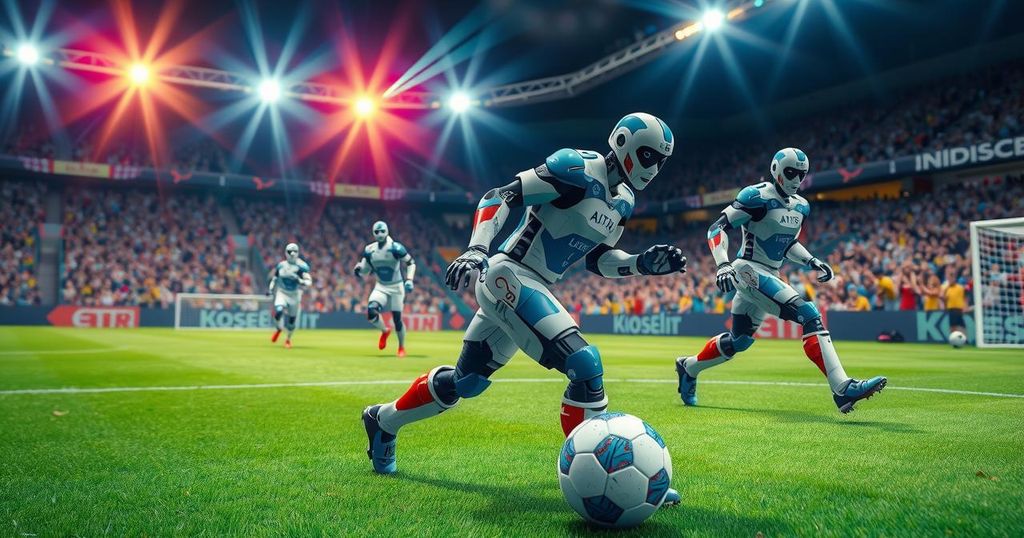China’s Robot Soccer Team Outshines National Squad
- China’s humanoid robot soccer teams showcased AI-driven matches.
- Tsinghua University’s THU Robotics defeated rivals in the finals.
- Robotics competitions are testing grounds for advanced AI technology.
- Safety for future human-robot games is a top priority for developers.
- The upcoming World Humanoid Robot Games will take place in Beijing.
China’s Humanoid Robots Step onto the Soccer Field
Advancements in Robotic Soccer Technology The landscape of sports is changing dramatically, and perhaps there’s no better exhibit of that evolution than the humanoid robot soccer teams in China. On Saturday night, in a spectacle that turned heads, four teams of robots, showcasing their own inbuilt artificial intelligence, participated in autonomous 3-on-3 soccer matches. This futuristic event, praised as a first for the country, was also a sneak peek into the upcoming World Humanoid Robot Games to be held in Beijing. Forget about the traditional sports strategies we’re used to; these robots executed plays on their own, completely unplugged from human guidance, driven solely by their AI algorithms. The emphasis was on technology, not so much on the physical feats of athleticism that one would expect from human teams. Humanoid Robots Showcasing Autonomous Skills Equipped with remarkable visual sensors, these robots maneuvered across the field with surprising agility, demonstrating their capability to identify the ball and react accordingly. Yet, it wasn’t all smooth sailing for them on the pitch; it became evident that while many robots were designed to regain their footing post-fall, a few still required assistance getting off the field, which added a strange touch of reality to the entire match. This complexity isn’t merely about kicks and goals—it’s about understanding how robots can one day integrate into various aspects of human life, including sports. Cheng Hao, the brain behind Booster Robotics, made it clear: robots must be safe, especially if they’re to eventually play alongside humans. He noted the essential balance between showcasing the robots’ competitive spirit while ensuring they don’t pose risks. Future of Sports Collaboration Between Humans and Robots As the competition unfolded, Tsinghua University emerged victorious, beating the China Agricultural University’s Mountain Sea team 5-3 in a tense match. Spectators like Mr. Wu expressed a mix of pride and admiration, indicating that both teams showcased immense talent. Nonetheless, the takeaway here extends far beyond which team won— it highlights a critical infusion of advanced AI into societal frameworks, using sports as a testing ground for technological boundaries. Cheng reiterates the broader implications: “We can work toward interactions where the outcome is secondary yet helps in understanding safety and reliability,” hinting at a future where humans could benefit from robotic teammates. As China continues to invest in developing humanoid robots through competitions spanning different sports, basketball, football, and boxing, the quest is not just for victory, but also for understanding how these intelligent machines can harmonize with human practices.
A Glimpse into Future Collaborations of Robots and Sports
Global Reach of Robotic Competitions and AI Integration With the trend of pairing robots and sports, it’s fascinating to think about the possibilities that lie ahead. It sounds like something out of a sci-fi film, yet here we are, on the brink of potential reality. The competition served as more than just an entertainment spectacle; it was a showcase of how technology fosters development in various domains, especially through challenges like these robotic matches. The market and horizon for AI technology are rapidly increasing; participation in such events doesn’t just favor progress in robotic competitiveness, but also advances algorithm development. Tsinghua’s win may seem like a mere academic victory, but it stirs up a larger conversation about how these machines might one day be fixtures in competitive sports worldwide. Each passing match contributes to a growing library of data that can shape safer, smarter algorithms for humanoid robotics. China’s Ambition in AI-Powered Technologies As we observe the frenetic pace of development—from humanoid robots to AI interactions in sports—it’s important to remember that wins and losses on the pitch are not where the real significance lies. The endeavor for safety and functionality underpins the entire tech spectrum engaged here, reminding audiences that every kick and pass is backed by intricate programming. As these experiments persist, we might witness the rise of unique partnerships blending human intuition with machine precision, forging new paths in traditional sports. The world may soon find itself eagerly anticipating not just who wins in robot matches, but rather, how these technologies rewrite the rules and interactions in sports altogether, expanding what we think possible beyond human limits. Global Collaborations in AI Sports Innovation With countries watching closely, as the World Humanoid Robot Games approach, anticipation builds for how this blend of entertainment and innovation will shape the future of sports—after all, whether robots launch into a new frontier of capabilities remains a question of both technology and trust. The anticipation swells with each robotic footfall on the turf, as these autonomous teams not only redefine sports but also challenge our understanding of coexistence between human athletes and their machine counterparts. The enthusiasm of spectators reflects how sports have always been about breaking new grounds, and now it may very well include breaking down boundaries between man and machine.
In summary, China’s robot soccer competition marks a significant leap into the intersection of sports and advanced technology. With teams demonstrating autonomous skills and the growing aim for safety with humanoid robots, it’s clear the future of sports may soon see human-robot collaborations. As this field advances, expectations rise on how AI will ultimately shape sports as we know it today.




